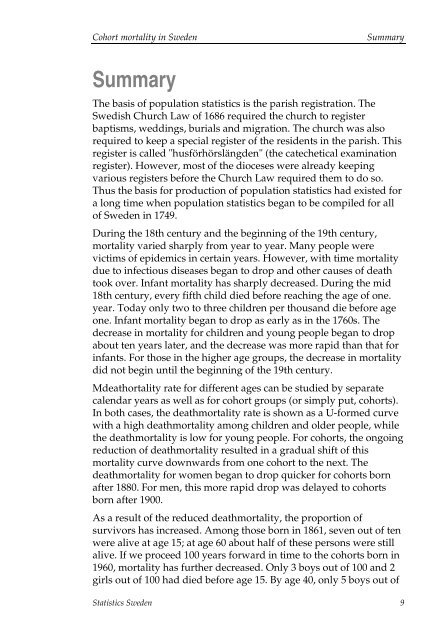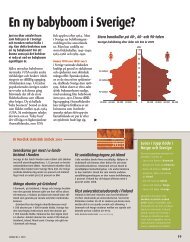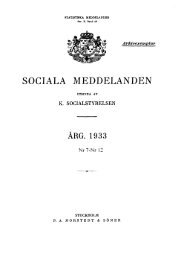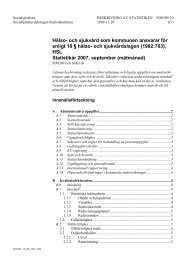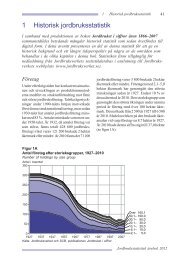Cohort mortality in Sweden (pdf)
Cohort mortality in Sweden (pdf)
Cohort mortality in Sweden (pdf)
Create successful ePaper yourself
Turn your PDF publications into a flip-book with our unique Google optimized e-Paper software.
<strong>Cohort</strong> <strong>mortality</strong> <strong>in</strong> <strong>Sweden</strong>SummarySummaryThe basis of population statistics is the parish registration. TheSwedish Church Law of 1686 required the church to registerbaptisms, wedd<strong>in</strong>gs, burials and migration. The church was alsorequired to keep a special register of the residents <strong>in</strong> the parish. Thisregister is called "husförhörslängden" (the catechetical exam<strong>in</strong>ationregister). However, most of the dioceses were already keep<strong>in</strong>gvarious registers before the Church Law required them to do so.Thus the basis for production of population statistics had existed fora long time when population statistics began to be compiled for allof <strong>Sweden</strong> <strong>in</strong> 1749.Dur<strong>in</strong>g the 18th century and the beg<strong>in</strong>n<strong>in</strong>g of the 19th century,<strong>mortality</strong> varied sharply from year to year. Many people werevictims of epidemics <strong>in</strong> certa<strong>in</strong> years. However, with time <strong>mortality</strong>due to <strong>in</strong>fectious diseases began to drop and other causes of deathtook over. Infant <strong>mortality</strong> has sharply decreased. Dur<strong>in</strong>g the mid18th century, every fifth child died before reach<strong>in</strong>g the age of one.year. Today only two to three children per thousand die before ageone. Infant <strong>mortality</strong> began to drop as early as <strong>in</strong> the 1760s. Thedecrease <strong>in</strong> <strong>mortality</strong> for children and young people began to dropabout ten years later, and the decrease was more rapid than that for<strong>in</strong>fants. For those <strong>in</strong> the higher age groups, the decrease <strong>in</strong> <strong>mortality</strong>did not beg<strong>in</strong> until the beg<strong>in</strong>n<strong>in</strong>g of the 19th century.Mdeathortality rate for different ages can be studied by separatecalendar years as well as for cohort groups (or simply put, cohorts).In both cases, the death<strong>mortality</strong> rate is shown as a U-formed curvewith a high death<strong>mortality</strong> among children and older people, whilethe death<strong>mortality</strong> is low for young people. For cohorts, the ongo<strong>in</strong>greduction of death<strong>mortality</strong> resulted <strong>in</strong> a gradual shift of this<strong>mortality</strong> curve downwards from one cohort to the next. Thedeath<strong>mortality</strong> for women began to drop quicker for cohorts bornafter 1880. For men, this more rapid drop was delayed to cohortsborn after 1900.As a result of the reduced death<strong>mortality</strong>, the proportion ofsurvivors has <strong>in</strong>creased. Among those born <strong>in</strong> 1861, seven out of tenwere alive at age 15; at age 60 about half of these persons were stillalive. If we proceed 100 years forward <strong>in</strong> time to the cohorts born <strong>in</strong>1960, <strong>mortality</strong> has further decreased. Only 3 boys out of 100 and 2girls out of 100 had died before age 15. By age 40, only 5 boys out ofStatistics <strong>Sweden</strong> 9


